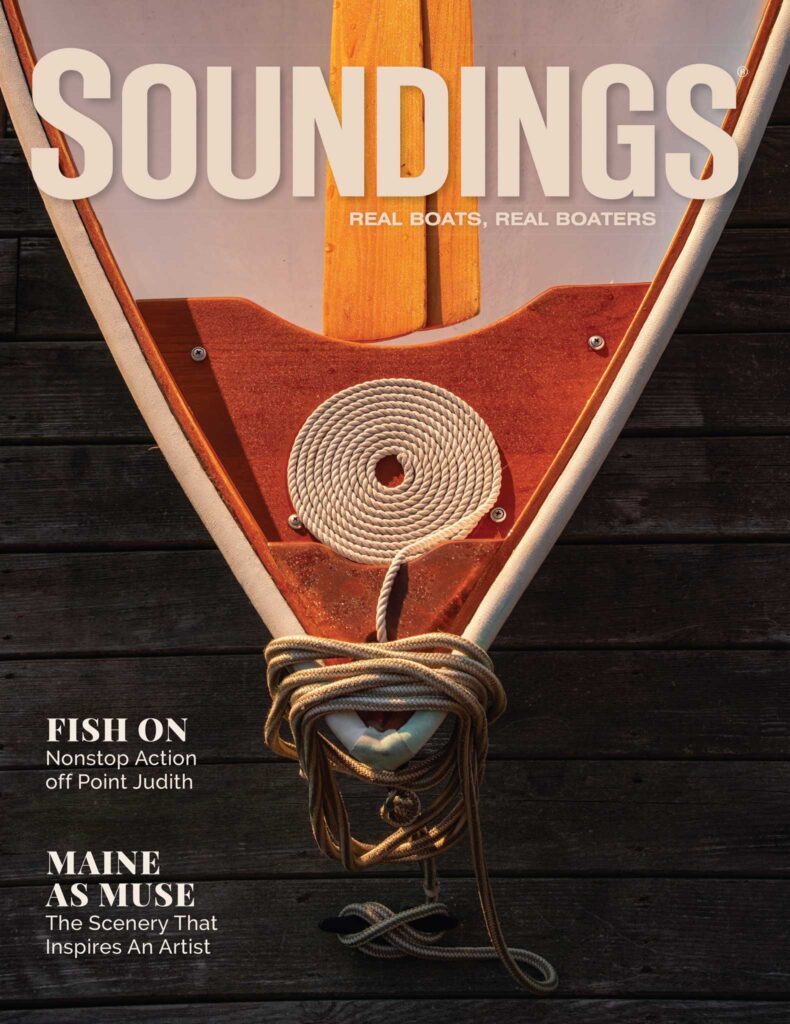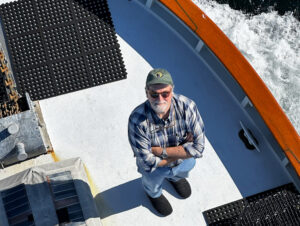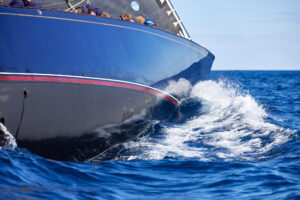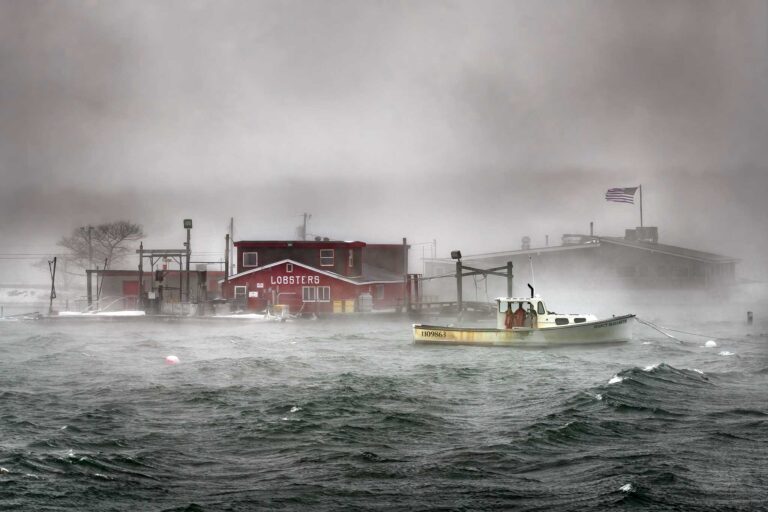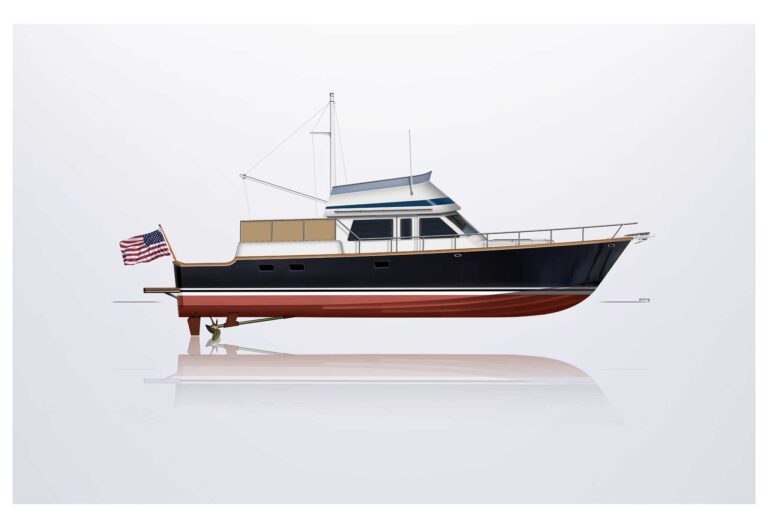We all dream of islands. I’ve been living and traveling on a boat for many years, and I’ve been going to islands most of my life. But I still always have a yearning for yet another island. Who knows which of the millions out there are truly “special islands”?


I’ve always heard of one that for centuries has been special, even mystical, to seamen. But until this summer, I’d never been there. True, it’s always haunted the back of my mind, but as just another island — now well beyond the fabric of its lore, now overwhelmed by hyperbole, now another creation of resort brochures. And once again, I found I was wrong. How nice to be so wrong.
She slowly rises, low in the water, when you approach from mainland Massachusetts. Sometimes she hides in the fog, appearing and disappearing through the gray shroud. So often is there fog here that seamen long ago began calling her the “Grey Lady.” Even so, seamen have found her countless times for thousands of years. It’s told that the Vikings sighted her, but of this we can’t be sure. We can be sure the Indians were there long before European settlers came to the mainland to stay.
Their legend is that a giant named Maushop slept with his head on what is now Cape Cod and his feet out to sea. His moccasins filled with sand and he kicked them off. One fell near and became Noepe, now called Martha’s Vineyard, but the other flew farther offshore and fell to become Natockete which meant “the faraway place.” It’s about 30 miles offshore, and it’s an island that anyone who loves being on the water can’t help but love to visit. It’s long been an island of seafaring people and still is today. It’s also an amazing vacation stop in your own boat, by ferry or by plane.
If you approach from the east, heading toward Sankaty Light, you see the sand cliffs rearing 90 feet or more out of the ocean. But those who approach from this direction are usually local fishermen who know the shoals and currents. Approaching from the west end, you see low, marshy islands that seem to be not much more than sandbars uncovered by storms and held together by marsh grasses. But you read the charts and see the breakers and the shallow cuts changing like will-o-the-wisps, and you know to bear far off unless you’re local with a small, powerful boat and know-how.
Most boats today approach through Nantucket Sound and, on a clear day, see Great Point Light rising from the ocean and then the jetties of Nantucket Harbor with Brant Point Light inside, the second-oldest lighthouse station in North America. The waterfront bustles as you come into the harbor, even though the actual town is quite small. From what you’ve heard over the years, you might expect only a Disney-esque tourist Mecca. But such is not Nantucket.
Tourists there are, as well as excellent restaurants, bars, lodging, and things to do and see. But the greatest show on the island is the island itself. She was spawned by a huge glacier that crept across a broad sandy plain near the prehistoric sea. As it moved, it pushed up a massive mound of sand that remained an island long after that ice age waned and the ocean rose again. Her population has risen and fallen; her shores have been savaged by waves and wind and then rebuilt by the same.
High seas and winds continued to form the island. Even today it’s a magnificent work in progress. In both old and recent times, bays have opened and closed to the sea. Houses on high dunes have tumbled into the ocean, and a lighthouse has been moved to avoid this fate. Wild, isolated, low out islands with beautiful beaches and marsh look out across the Atlantic. Currents rip around them. Passages through shoals change at the whim of storms, and you can walk on beaches completely alone.
The people native to the island have also changed, while maintaining the common denominator of those who love the sea and islands. At first, of course, were the American Indians, as many as 3,000 at one time. The island is marked by their language at almost every turn. In 1602, 32 Brits landed there while looking for Virginia, and European influence began. The island was sold to other settlers in 1659 for $54 and two beaver hats.
The early inhabitants led a bleak and lonely life, but eventually wealth and prosperity came — from shipping and primarily from the oil of the whale. For many years, the most successful whaling fleet in the world sailed from the harbor on voyages that spawned legends. At one point, it’s reported there were 88 of these vessels. These voyages often lasted as long as three years and extended to the South Pacific, where Nantucket seamen discovered and named at least 20 islands.
But with the advent of oil from the ground, there was less demand for the pure oil of the sperm whale, and around the mid-1800s the harbor entrance shoaled so severely that whaling and other large ships couldn’t safely enter. The island had hard times again.
But its people have always been special. Living on a small island 30 miles off the mainland, under constant siege from the sea, they’d have to be. Family names such as Macy, Folger and Starbuck would become nationally known. Benjamin Franklin’s mother was born here, and it was with his second cousin, Nantucket whaling captain Timothy Folger, that Ben Franklin charted the Gulf Stream. You wonder, as you approach from the mainland, how much of this heritage remains. Not to worry.
For you and your boat
When you round into the harbor today, much of this history surrounds you. Steamboat Wharf and Old North Wharf lie to port, where the waterfront accommodates ferries, freighters and launches. Straight Wharf, Old South Wharf and Swains Wharf spread ahead, where lie the 243 slips of the Nantucket Boat Basin (www.nantucketboatbasin.com). The marina caters to transients, and George Bassett, the director of marina operations, says approximately 85 percent of its business is repeat. Small wonder.
The marina is first-class in every respect and is carefully operated with a goal of offering services like a five-star hotel while keeping the waterfront area immaculate. This doesn’t surprise you when you learn that George spent 26 years in the Coast Guard, retiring as a CWO 4 BOSN before working for the last 23 years in his current job. He’s also an avid boater and fisherman.
This marina can accommodate more than 25 boats more than 100 feet long, as well as all other sizes. George says the summer occupancy rate is about 95 percent, so reservations are important. I asked him about fog.
“When it’s foggy, about 99 percent of the people will take the chance to get here,” he told me, “and about 99 percent of the people who are already here will say that they don’t want to leave.”
The facility has a fully staffed concierge service, all the amenities you could imagine, and is a brief walk from the center of the historical town of Nantucket. And it has a specially designated “Pet Needs” park with a sign making clear your pets are free to “go” there — but you’re not.
There are also 125 moorings in the harbor, owned by Nantucket Moorings. Call (508) 228-4472 or hail Nantucket Moorings on VHF channel 68. A launch service also stands by on VHF 68.
Nantucket Boat Basin has a unique feature. In various locations around the docks are The Cottages at the Boat Basin (www.thecottagesnantucket.com). These are one-, two- and three-bedroom luxury suites in renovated cottages, some at wharf level, some as lofts. They have modern kitchenettes, daily room service and concierge services. They give you the quiet and privacy of your own home, but they’re where the action is.
There’s a provisioning service, and you can also stock your cottage (and your boat) from a well-stocked grocery store within short walking distance. The cottages offer a great “escape” from the boat if you want to sleep ashore while on the island, and they also provide a great opportunity to have your guests off the boat for a few days.
The Cottages and the marina are both owned by Nantucket Island Resorts (www.nantucketislandresorts.com), but you must book separately. However, it’s often possible, with notice, to arrange dockage close to or in front of the cottage you or your guests will use. And if you come without your boat, you can still enjoy being in a marina if you stay in one of the cottages. It’s like having your own luxurious little home with complete privacy, but you’re on the waterfront in marina surroundings and a short walk from “all the action” in the village.
Nantucket Island Resorts also owns several other first-class resort facilities, each of which achieves a unique blend of luxury resort experiences with the island’s natural character and that of the sea.
It’s time to stroll
I’ve mentioned walking frequently because it’s the way to get around in the village, which is small in acreage but huge in attractions. “Pedestrians rule” is a statement I heard repeatedly. I don’t recommend pushing the issue as a pedestrian, but we noticed that cars stop for pedestrians throughout the village. Cars can’t travel fast anyway because of the cobblestones and bricks, and they not only stop for pedestrians but for each other. There are no stoplights on the island. It’s a different world.
You can bring a car to the island on one of the ferries, but most come on a passenger-only ferry and have no difficulty getting around, without the encumbrance of their own vehicle. Your feet will take you all around the village, and bicycle rental shops such as Young’s (www.youngsbicycleshop.com) can introduce you to miles of biking paths. A public shuttle can take you over most of the island’s approximately 50 square miles.
“Walking distance” from the marina and cottages includes innumerable restaurants and bars, countless shops, historical landmark buildings, inns and magnificent homes of wealthy sea captains from the whaling days. Some of those homes are now inns, and some also contain restaurants.
A stellar example is the Jared Coffin House, built in 1845 by one of the most successful ship owners of the time and now a fine inn (www.jaredcoffinhouse.com). It’s in the heart of the downtown historic district, but as you sit in its gardens you feel the quietness of the days when the original owner lived there. While staying there, enjoy the atmosphere of its library, along with a glass of wine, or just a relaxing moment — as things used to be.
On the premises is the popular Harbor Wok restaurant, where you can enjoy — seated inside or out under the beautiful trees — authentic Chinese cuisine prepared on site. Those who stay in this inn, as is true of other Nantucket Island Resorts properties, get a 15 percent discount at some of the restaurants owned by NIR.
Visit the Whaling Museum shortly after you arrive. Also a short walk from the marina, it takes you into the essence of the history of the island and includes not only models, pictures and artifacts, but a whale boat, harpoons and other whaling gear saved from that age, not to mention a fully restored 1847 spermaceti candle factory.
There are logs, memorabilia, photographs and other relics from the voyage of the Essex, which departed Nantucket in August 1819. Essex was rammed by a sperm whale Nov. 20, 1820, culminating in loss of the ship, days of survival in small boats, and the death of many crewmembers, including some by cannibalism, as lots were drawn to see who would feed the others so some would survive. Nathaniel Philbrick wrote “In the Heart of the Sea” about the Essex, and it’s said this tragedy and other parts of the history of Nantucket helped to inspire Herman Melville’s “Moby Dick.”
The centerpiece of the museum is the skeleton of a 46-foot sperm whale that foundered and died on one of the island’s beaches in early 1998. Islanders tried desperately to save it, and when it passed on they labored for days to save its oil and clean its bones to preserve it as you see it today. A movie, played in the museum, tells the story. The bones of a sperm whale are so enriched with oil that they had to sink the skeleton for months in the harbor so the bones could be naturally cleansed.
While in the museum shop you can arrange for a guided historical walking tour around the town. The nearby Nantucket Island Chamber of Commerce at Zero Main Street (www.nantucketchamber.org) also has much information available. Before leaving the museum, go to the open observation tower and look around at the harbor and the rest of town. It’ll give you a great perspective of where you are and what you want to do next.
Truly historical
Obviously you’re in a tourist area when you’re in the village, but there’s much there to remind you of what the island is really all about. The town doesn’t need to try to be historical; it simply is. Many towns and cities today try to create an aura of historical authenticity by laying streets and sidewalks with perfectly squared and well-fitting “designer” bricks. In old Nantucket, the bricks are of all sizes and shapes, pieced together however they originally fit. It has the greatest number of designated historical landmark sites in Massachusetts — the state where the Mayflower landed.
Places to stay, historical and famously elegant, surround you, from those in the old town section of the historic district to outlying areas. As an example of the latter, a short walk from the marina over to quiet Easton Street fetches the elegant and luxurious White Elephant hotel. You will probably have noticed its grand columns and green lawn to your starboard as you came into the harbor. With its 53 rooms and suites, 11 garden cottages, full-service spa and award-winning dining, it’s an island landmark (www.whiteelephanthotel.com).
Nearby are the White Elephant Hotel Residences, where you can privately purchase a new island home. The Brant Point Grill is located in the hotel and features dining outside — if you wish — on the spacious porch overlooking the harbor and all the yachts and other vessels coming and going. Next door is the Children’s Beach, so named because it’s in town, inside the harbor, and isn’t affected by ocean waves. It’s perfect for young kids and families. While we were there, a Shakespearean play was performed one evening, and the public could watch, including those at the Brant Point Grill and those on many boats out in the harbor.
Exploring the town is always interesting. For example, a walk down “The Strip,” the water end of Broad Street, introduces you to Young’s Bicycle Shop, fast food and other places popular to young people. At the right time of day, you can also see the freight ships dock with trucks rolling on or off.
The Petticoat Row section of nearby Centre Street reminds you of the days when so many men were at sea, and the women conducted much of the business in town. If you duck into Old North Wharf from Easy Street, you’ll find a small, unpretentious building (though I’m sure I couldn’t afford to buy it in several lifetimes) that’s the headquarters of the “Wharf Rats.” This is, I’m told, a group of local guys who aren’t about impressing people and being fancy, who are fond of telling great tales and are friendly to all, but who keep their “official” membership very small. I stopped by several times just hoping to talk, but never found anyone there. (They probably saw me coming.)
On Fridays and weekend nights, it isn’t unusual to see entertainers such as guitarists and singers performing on sidewalks or in storefronts about town. As we walked one evening, we were amazed to hear fantastic singing in harmony, a cappella, coming from down the street. We found the Nantucket Cobbletones, seven young men I’d guess ages 15 to 18, performing many types of songs, including well-practiced choreography, with art, talent and skill that I thought had been mostly forgotten. It was not only entertaining, but inspiring.
In the evening, we also walked the docks. In the main harbor there’s a town dock where many islanders keep their boats. You’ll probably see children and adults fishing at night, often catching squid they may use for bait or for calamari. It’s the way the place is. People are there because they love it, and there’s an essence to the island that goes far deeper than tourism.
Out of town
To understand this more, head out to the rest of the island after you’ve explored the town. You’ll be amazed at what you find. You’ll find old houses with “H and L hinges,” which meant “Help us Lord against witches.” You’ll find old-timers who’ll tell you of the Yoho, a mysterious ghost or mythical (is it really?) creature that was sometimes seen in the fog by those who were out at night when they should have been safe at home by the fire. You’ll find a huge bog area where cranberries are grown and harvested.
Nantucket cranberries are famous, and the fashionable, trademarked Nantucket Red color, which you see widely used in clothing (in particular men’s pants), is said to have originated to reflect the color of cranberry dye. You’ll notice familiar flowers you may have known all your life, but here the plants grow larger, and their colors are intense. Hydrangea is everywhere, with deep raspberry, bright blue and purple blooms. Locals told us this is because of the cold winters.
You won’t notice any tall stands of trees because the winds, which come with the storms — particularly in the winter — can be so strong and long-lasting. There are, however, four well-known golf courses on the island, which is about 40 percent conservation land.
If you visit Bartlett’s Farm (www.bartlettsfarm.com), the island’s oldest and largest family-owned farm, you’ll find a market that sells its own produce as well as other products. I’m from Tidewater, Va., and proud of it, so it’s with great chagrin that I admit I’ve never tasted better corn on the cob than what I ate, grown on that farm.
You’ll also find Cisco Brewers (www.ciscobrewers.com), with a winery, distillery and vineyard. My favorite is Whale’s Tale Pale Ale. I won’t try to describe it. You’ll have to pick your own. On the premises are tasting bars for beer, wine and other beverages.
Obviously, you’ve seen by now there’s far more to the island than the town where you landed. For example, the village of Siasconset (called “Sconset”) is living proof of that age-old truth of mankind: never tell another where the fish are biting. The Indians told the British, soon after they came, that the fishing was good off what is now Sconset Beach. This is because of the currents racing back and forth there. The British wasted no time in checking it out and found fishing to be so good that they began to build shacks along the beach. Much later, a railroad was built across the island to facilitate getting there.
The Indians from the other side of the island originally had a much more basic way of reaching those fishing grounds by water. They dragged their canoes across a haulover at the northeastern end of Nantucket Harbor (Head of the Harbor). This was a narrow strip of sand separating that end of the harbor from the ocean and connecting to Great Point, the lighthouse you may have noticed as you came in from the mainland.
The settlers, of course, copied this practice with their boats, and from time to time the strip of sand wore or washed through, opening the Head of the Harbor to the ocean. Now this practice is forbidden, but it engendered another tradition that you should enjoy today.
Some enterprising soul long ago figured that the fishermen dragging boats over might like a place to eat and drink, and set up an establishment of sorts near the haulover. Today you’ll find a fabulous inn, The Wauwinet, named after an early American Indian chief. It has luxurious guest rooms, access to both ocean and harbor beaches, a spa and many other amenities, not to mention the superb fine dining at TOPPER’S. Be sure to watch the sun set over the harbor from the lawn.
The trip to The Wauwinet is much too far from the marina and town for walking, but the inn, also owned by Nantucket Island Resorts, provides land and sea transportation. The Wauwinet Lady is a 26-foot launch that docks at the shore end of Straight Wharf, which is close to the marina and cottages, the White Elephant and the Jared Coffin House, as well as most other lodgings in town. The ride through the main harbor and mooring fields and then out to the Head of the Harbor takes around 50 relaxing minutes.
During the trip you can study the menu if you wish and purchase beverages, including fine champagne. It’s interesting to realize, as you cruise through the bay toward your dining experience, that the waters around you are where the famous Nantucket bay scallops are harvested in season.
This trip is beautiful and incredibly relaxing, particularly when you realize that the skipper of the launch, Capt. Rob McMullen, is an area native and seaman, as well as a history buff. He knows enough local lore, legend and fact to fill books, not to mention to make the trip a fascinating learning experience if you ask.
Rob lives much of the time on his saiboat, Wanoma (the name of Chief Wauwinet’s daughter), on a mooring in the harbor. He’s sailed to many other areas, sometimes on deliveries, and has worked for NIR for about 15 years. He also does other things for the resort, such as taking guests out to retrieve lobsters from the traps in season, teaching them about the creatures, and then carrying the lobsters back for preparation for dinner.
When the launch docks, the manager of TOPPER’S meets you at the dock, describes some of the possibilities of the evening, and escorts you up the grassy green hill, past the chef’s personal herb garden.
As you’d imagine, entrees vary and are excellent. The wine list is awesome, but there’s a well-versed sommelier, Craig Hanna, to assist if you’d like some help in choosing. When we were there, we chose a “tasting” entrée specialty that comprised small portions of just about everything good you could imagine on the main menu. It just kept coming and included oysters with three different kinds of caviar, scallops with parmesan foam cheese and bacon bits, pork topped with ravioli with a fresh egg yoke perfectly cooked inside … I could go on, but I’m embarrassing myself.
And then there are the beaches. Nantucket has about 80 miles of beaches, and they’re not only spectacular but, unlike many beaches in that section of the world, the sand is soft, not rocky or grainy. Some, such as Surfside, have great waves for surfing or body surfing. Sconset Beach lies beneath an approximately 90-foot-high sandy cliff, some of which caved in during the Halloween Storm of 1991, when the wind blew at about 80 mph for four days. You can see actual video of this and houses being washed into the waves at the Whaling Museum. Nearby Sankaty Lighthouse recently had to be moved back to keep it from falling over the edge.
There are beaches that remain unknown to most visitors. They’re off Smith’s Point at the western tip of the island. They’re isolated, with no power or electricity and only a few vacation homes. These are the small islands I referred to earlier; the main one is Tuckernuck. You often see harbor seals here. We wouldn’t have known about them if we hadn’t met Capt. Tobey Leske.
Capt. Tobey is a native and loves the waters. He also knows them. He operates what some would call a water taxi, but he’ll make the trip for you, as and when you want (www.tobeyleskeinc.com). He’ll take you to these places that others don’t know, and he’ll tell you about what you’re seeing as you go. I wouldn’t recommend taking your own tender to many of these places because, without local knowledge, you’re likely to go aground or get lost in the shallows.
Capt. Tobey also took us to the tiny village of Madaket. It’s also on the western end, on Hither Creek, where there’s a marina and yard. Here, he told us, lived island heroine “Madaket Millie,” who passed on in 1990. Tobey told us her reputation was that of a kind person with a heart of gold, but who could put the severest of frowns on you if you gave her cause. Millie also scalloped, fished and would sometimes go with little or no food to feed the many animals she loved. And she saved lives.
The Coast Guard closed the watch station on the western end of Nantucket, and within days she reported to them a freighter aground on the shoal. Its captain was confused and calling in a distress from a far different location. She continued this watch and service throughout her life. Millie was eventually awarded the Coast Guard’s most esteemed civilian designations as honorary Chief Warrant Officer 4 and honorary Commanding Officer for her dedication to helping the Coasties and saving seamen.
Anything else?
There are numerous festivals on the island from April to December. A visit to the Chamber of Commerce Web site (www.nantucketchamber.org) can tell you what’s going on and when. These include the Nantucket Billfish Tournament in August and the Figawi Race Weekend in May, the name for which I’m told by many came from what early sailors of the area kept saying when lost in the fog: Where the —— are we?
But you’ll know where you are. You can even come by boat if you’ve left yours at home, with no worries about navigating. There are two ferry lines. However you come, you’ll be glad you did.
As we watched Nantucket recede astern after our stay, I couldn’t help but think: may there always be islands. May there always be seas to insulate them and keep them uniquely special. May there always be surprises when we reach them. And may those surprises be good, like Nantucket.

